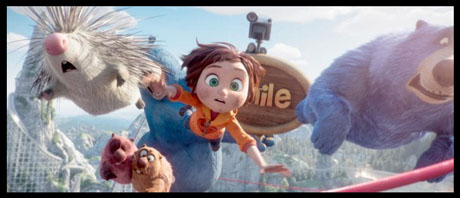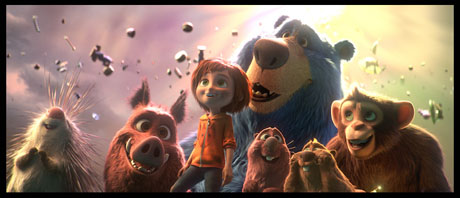
Cameron “June” Bailey is an irrepressible young girl who, by age 10, proves capable of mentally designing an amusement park that Disney’s Imagineers would envy. Her parents admire her creativity; Mom whispers June’s suggestions into the ear of Peanut (a monkey with a magic pencil) and a magical ride appears in June’s imaginary “Wonderland”. (Makes me wonder: The Park is never once referred to as “Wonder Park”. It’s called “Wonderland” throughout the entire film).
When Mom becomes seriously ill and relocates to a distant medical facility, June becomes despondent, dismantles her models of Wonderland and burns the blueprints. A fragment escapes the flames and leads June to the ruins of the Park, now in the process of being dismantled by an evil cloud called “the Darkness.” The Darkness’ minions, an army of souvenir toys called chimpanzombies, have the original stars of Wonderland on the run.

These refugees consist of oft-feuding beaver brothers Gus and Cooper, A narcoleptic blue Bear named Boomer, Greta, a canny wild boar, and Steve, a raffish porcupine who pines for Greta. Peanut, the grandmaster of the park, has disappeared and presumed to be a victim of the minions. It’s up to June and this offbeat crew to start up a crucial ride and thus restore Wonderland to its former glory.
Newcomer Briana Denski, who beat out 1500 hopefuls for the role, voices the perky and determined June in fine form. Veteran Actors Matthew Broderick and Jennifer Garner turn in good performances as well. Keenan Thompson (Gus) and Ken Jeong (Cooper) are fine as brotherly cutups. (Makes me wonder: was this a sly nod to co-producer Nickelodeon’s Angry Beavers?) Mila Kunis turns in a surprisingly nuanced performance as Greta, and John Oliver nearly steals the show as the voice of Steve. Ken Hudson Campbell does well enough as Boomer, but Norbert Leo Butz sounds a bit too serious for the role of Peanut.
The animation, handled overseas by Spain’s Ilion Animation studios, is dazzling. Animation Director Javier Abad and Visual Effects Supervisor Javi Romero led a team reportedly consisting of a mere fifty people. None of the animation effects are simple, and the faults are few. The final victory over the Darkness (thanks to magical bendy straws) is a masterpiece of color and frenetic action. Wonder Park is a visual showpiece for the new Paramount Animation division, producing the film in collaboration with Nickelodeon Movies. Multiple trailers and teasers aired on Nick and elsewhere, making for a huge promotional push. In fact, some commercials for the film featured clips that were not in the movie.
Paramount’s start-up animated feature succeeds despite its bumpy ride en route to theaters. Originally titled Amusement Park, the movie began production five years ago, and during that time its release date was either moved up or pushed back five times. First time Director Dylan Brown, a Pixar graduate, was fired as the film neared completion. Nickelodeon veteran David Feiss stepped in to tie up the production.

There are strong echoes of Pixar’s Inside Out in the film. Both feature a fantastic mindscape that exists in the mind of a despondent young girl. The difference is that Ashley is unaware of the entities operating in her mind while June created hers by animating her stuffed animals and interacting with them. The main problems with the film are the ones that Inside Out manage to avoid. The screenplay, written by Josh Appelbaum and André Nemec, is at times inconsistent and confusing largely due to June’s awareness of her own imagination.
For example, how many manifestations of the Park are there? Why would its ruins be located in the middle of an unfamiliar forest when June finds it? Peanut appears to be helpless to control his magic pencil because June’s mom is not whispering in his ear, so whose imagination was more instrumental in creating the park, June, Mrs. Bailey, or Peanut?
We learn that June created both the Park and the Darkness that is destroying it, but what is the animating spirit behind the crucial piece of paper that eventually helps restore the park? June’s Mom? Some residual spark of June’s imagination that survived her grief? Was it guided by the desperate animals? Eventually June takes Mom’s place and whispers inspiration to Peanut, but why didn’t she do that that several scenes earlier when she came across Peanut on the zero gravity ride?
Makes me wonder: Several scenes portray June as an excellent scale modeler, yet she enlists most of the neighborhood kids in building a huge jury-rigged amusement ride that takes off from her roof, vaults into a city street, and nearly kills her and her best friend Banky. Why didn’t she build a smaller prototype and let Barbie test it out? Her parents, in the same house, seem unaware that all this noisy construction is even happening. After the debacle, her concerned but adoring parents issue no punishment. Most kids who nearly leave their parents childless and hung with the liability of killing another couple’s kid would at least do time on the Grounded-For-a-Month-No-Thrills Ride.
But that’s for reviewers to wonder about. Kids won’t care about any of that. Wonder Park, despite story inconsistencies, is a sturdy piece of entertainment that will likely do well even without the Disney/Pixar imprimatur. In the end June’s mother comes home cured, Wonderland thrives in its imaginary state (and also in June’s backyard), Steve wins Greta’s love, and Nickelodeon will soon launch a CGI TV series based on Wonder Park.
Makes me wonder: Are they going to call it Wonder Park or Wonderland?
- ANIME REVIEW: “Lonely Castle in the Mirror” - September 24, 2023
- REVIEW: “Teenage Mutant Ninja Turtles: Mutant Mayhem - August 15, 2023
- REVIEW: “Spider-Man: Across The Spider-Verse” - June 7, 2023


 March 15th, 2019
March 15th, 2019  Martin Goodman
Martin Goodman  Posted in
Posted in  Tags:
Tags: 






